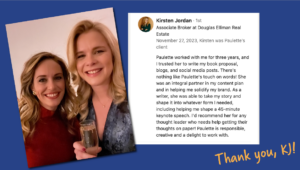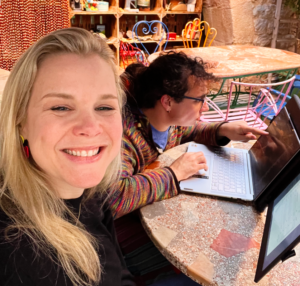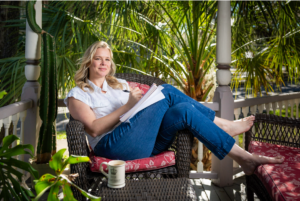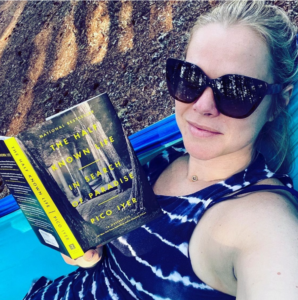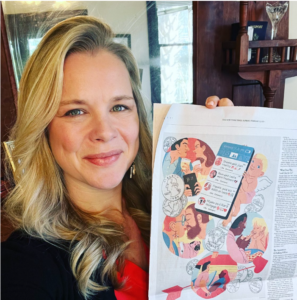I just hit send on a submission for Modern Love, letting out a sigh and flopping back in my chair like I’d cross the finish line of an Iron Man. The word limit is 1,700 and the doc i\was 1,705 words, but with a 9-word title and only 2 brain cells not fried out from editing it, I felt ok. The same way my suitcase always hefts in at 49.6 pounds, I am almost always pushing the upper limit of my word count. Writing, to me, has long been a practice of cutting.
My darlings!
Psst: This site uses affiliate links.
I haven’t worked on a piece as intensely as this one in at least a year. From the various morning page sessions to a typed first draft in Scrivener, to Google Docs so I could get opinions and comments, then a V2 Google Doc, then back to Scrivener to use its linguistic focus tools, the essay ballooned up to 2,015 words, then back to 1873, then as I edited to cut further, somehow up to 1921.
Once you’ve worked on something for a month, and you’re 30-40 hours, you become blind to the bulk. You’ve read each sentence 20 or 30 times. You’ve perhaps created a plot chart and an outline to make sure every paragraph shapes the essence of the story. You have ten pounds of narrative in a five-pound call-to-submit, and yet, you just don’t know how to shove all you want to say in.
It is for this moment of desperation that I surrendered to the nerdiest way of cutting ever.
Turn your story into a tweet
Almost every time I tweet, those red, negative numbers pop up, showing me how many characters I’ve gone over. As I’m editing down, seeing where (of course!) I can cut, I think about what a good editing exercise tweeting is.
So, when I’m at the very end of editing a story, just trying to make that word limit, I look at every paragraph like a tweet. Rather than look at the entire essay and the daunting three- or four-digit number of words I need to cut, I look at each paragraph and get rid of the number of words that will contribute to the overall trimming.
This involves math, which, for me, means that it involves a spreadsheet. First, I figure out the percent I need to cut. As a rule, I always do this equation wrong the first time. But then I get it. If the essay has 1,873 words, and I need to cut it to 1,700, I freak out about the 173 words. It feels slightly easier to think of it as 9% of the words. Ok, deep breaths.
Then I zoom way in, and meet my goal paragraph by paragraph.
What I do, (and again, I can’t believe I’m telling you this), is I go through each paragraph, highlight it, see how many words are in it, and multiply that number by, in this example, 9%, to see how many words I’d have to cut from this paragraph in order to meet the goal. In a hundred-word paragraph, it would mean 9 words. Nine words feels much more doable than the 173.
Wow, that seems like a lot, you might be thinking. I’m telling you I do this when I feel like I have nothing left to give. To do this, I must have already worked on a piece for at least a month, be exhausted by the effort, going to bed at night with the first line imprinted on the back of my eyelids, because I’ve stared at it for so long.
By this time, I know that the message of each paragraph is needed in the story, it’s right there on the spine of the plot.
This system, as nerdy as it is, has really helped me in that last mile toward deadline. So I decided to just make the sheet official and keep it for the next time I need it. Plus, give it to you!
Here’s the spreadsheet you can use, along with a checklist of ways to trim, trim, trim.
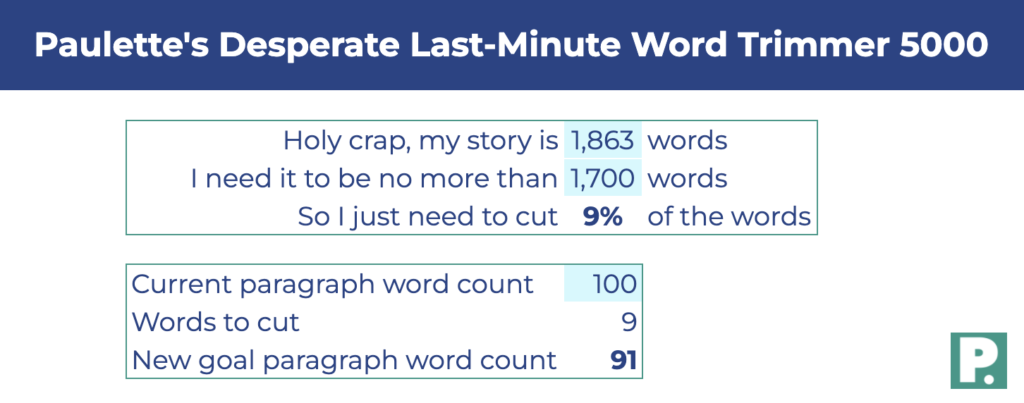

![2022.03.10 – Paulette Clipping Grass for Blog[26] 2022.03.10 - Paulette Clipping Grass for Blog[26]](https://welcometothewriterslife.com/wp-content/uploads/elementor/thumbs/2022.03.10-Paulette-Clipping-Grass-for-Blog26-plofi63bcmw8k78n5pltoj8b1st6jpwk225d9vm5cw.png)

